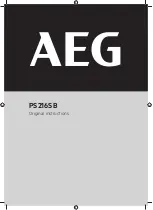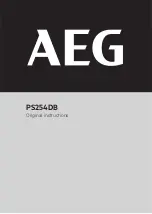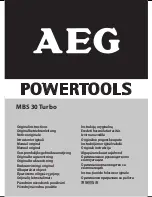
fig. 3
fig. 7
fig. 8
fig.9
3.5.
USE OF THE SIDE FENCE SAWING GUIDE.
3.5.1 Where a suitable straight edge exists on the workpiece the side fence guide may be used.
3.5.2
Disconnect the saw from the mains power before fitting the guide.
3.5.3
Slide the side fence with the measuring scale upwards into the pressed metal guides
in the base plate as shown in fig.7. If necessary loosen the clamp knob to allow the
guide to pass through. Set the guide at the required width and tighten the clamping knob.
3.5.4
To avoid the blade binding in the cut and causing kickback keep the face of the fence
guide pressed firmly against the edge of the workpiece when making a cut.
4. OPERATING THE SAW
4.2
MAKING A CUT.
4.2.1
The workpiece must be fully supported and marked out prior to commencing the cut.
4.2.2
Ensure that the saw is correctly set up for the cut you wish to make and that there is a suitable edge guide to achieve a straight cut.
4.2.3
It is advisable to test the cut on a suitable piece of scrap material first to test the accuracy of your set up.
4.2.4
The saw has a safety lock-off button to prevent accidental operation.
4.2.5
To start the saw, press and hold the safety lock-off button and then squeeze and hold the trigger switch (fig.9). The saw will start. ( When the
trigger switch is depressed it is not necessary to go on holding the safety lock off button.)
4.2.6
To stop the saw release the trigger switch, which will then automatically lock-off for safety.
4.2.7
With the saw switched off, place the front of the saw base onto the workpiece, with the blade guard behind the edge where the cut is
to start. ( If necessary use the alignment notches on the front edge of the saw base to align the blade with the line of cut. See
fig.10) Switch on the saw and allow the blade to run up to speed. Move the saw forward slowly and smoothly. As the blade guard
moves out of the way the saw will commence cutting.
DO NOT attempt to start the saw with the blade in contact with the workpiece.
4.2.8
When the cut is complete release the trigger and allow the blade to come to a complete stop before removing the saw from the workpiece.
p
WARNING!
The trigger switch and the lock-off button are not to be removed or tampered with, e.g. by tying down the trigger switch to the
handle, or the saw will not switch off automatically, or will not lock-off, and there will be a high risk of personal injury.
p
Important!
Wear safety goggles and a mask to prevent eye injury and dust inhalation.
4.0
BLADE GUARD SYSTEM.
The saw is fitted with a lower blade guard system which automatically opens as you
feed the saw into the workpiece and automatically closes as the saw is withdrawn
from the workpiece. This guide is there for your protection and should not be
tampered with or modified in any way. Do not wedge the blade guard open. If the
unit is accidentally knocked or dropped check that the blade guard still operates easily
and smoothly. If the blade guard is damaged stop using the saw until the guard is
repaired or replaced.
p
WARNING!
When the saw is cutting, the portion of blade that is protruding
underneath the workpiece is not covered. Do not reach underneath the workpiece
whilst the blade is cutting. Keep hands away from the cutting area and do not attempt
to remove cut material whilst the blade is still turning.
4.1
KICKBACK.
Kickback is caused by any action which pinches or jams the blade during the cutting
process. If the blade stalls rapidly the saw will be driven back towards you.
p
WARNING! If kickback occurs release the switch immediately.
Kickback could
cause you to loose control of the saw leading to serious injury. For this reason it is
important to hold the saw firmly and correctly with both hands as indicated in fig.8.
The main causes of kickback are listed below and in general relate to bad workshop
practice and poor technique.
4.1.1
Incorrect blade depth setting.
Twisting the blade whilst making a cut.
Forcing the saw to cut.
Using a dull, gummed up or incorrectly set blade.
Sawing into nails or knots in the wood.
Workpiece not adequately supported.
Cutting warped or wet timber.
Saw blade incorrectly fitted.
Damage to the saw through misuse.
4.1.2
The incidence of kickback can be greatly reduced by observing the following points:
4.1.3
Always ensure that the blade is set at the correct depth. The blade should not protrude
more than 6mm below the material being cut.
4.1.4
Inspect the workpiece for knots, nails, screws and other metal fixings before cutting.
This is particularly important when reusing timber that has previously be used for some
form of construction or when modifying an existing structure .
4.1.5
Always use a straight edge guide when rip cutting (along the grain of the timber).This
helps to avoid twisting the blade in the cut.
4.1.6
Always use clean, sharp and properly set blades. Avoid making cuts with dull blades.
4.1.7
When making a cut use steady, even pressure. Do not force the saw to cut.
4.1.8
Do not cut wet or warped timber.
4.1.9
To avoid pinching the blade, all parts of the work piece must be fully supported.
4.1.10 Hold the saw firmly with both hands keeping your body in a balanced position to
counteract the force of a kickback should it occur.
fig.10
SCS1400 - 2 - 200603























